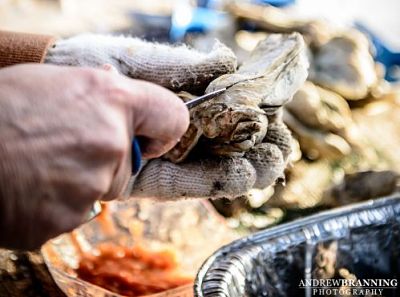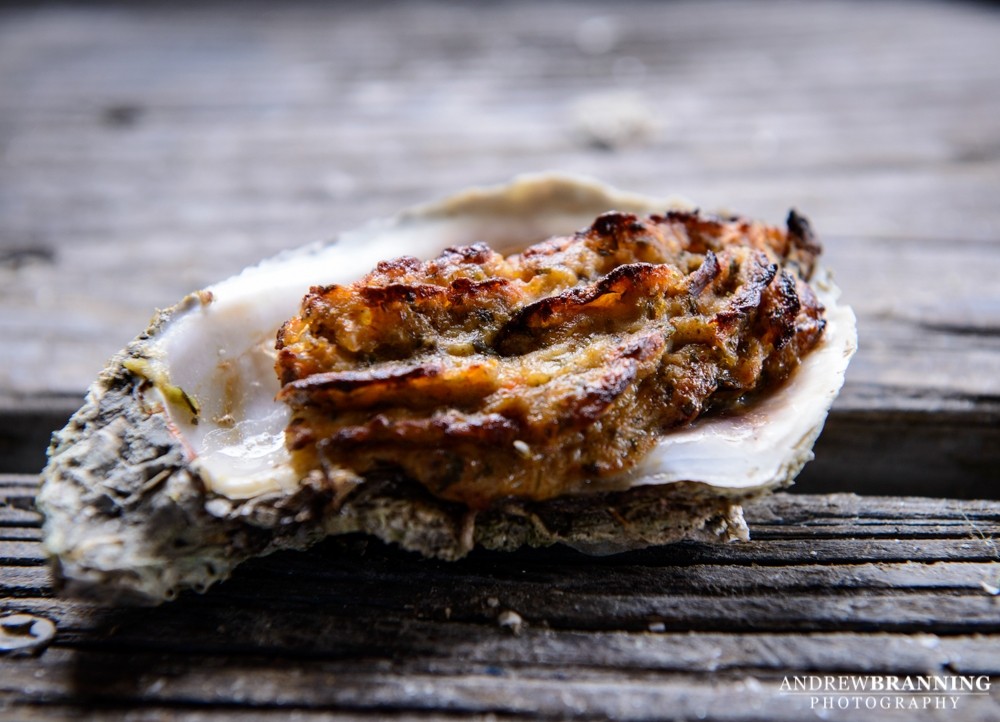A Lowcountry Oyster Roast
Every winter when the waters around Lady’s Island are cold enough to produce oysters with just the right amount of salinity, there are oyster roasts.

Found in abundance along the Beaufort coast, they are a delight to both natives and tourists. Anyone can buy them off the docks and use them in recipes made famous at parties along the river bluffs. The local oyster-picking season runs between October 1st and May 15th.
If you’ve never been to a roast, it’s a delight for the senses that will keep you coming back again and again. It’s time to bring the whole family together from the smallest babies to the great grandparents. As families gather around the open fire, the men shovel oysters onto a large steel plate, and then cover them with wet burlap bags. This steams them open and they’re ready to be shoveled onto tall wooden tables where the crowd stands ready with their oyster knives and gloves. It’s a taste of the sea with every bite.
What hasn’t been written about oysters? The local oyster tradition began in the 2nd Millennium B.C. We recognize that because one of the massive, archeologically rich shell rings known as Fig Island located near Botany Plantation is on the National Register of Historic Places. Early oyster shucking tools have been discovered there as well as fragments of pottery and blackened shells: a sure sign that cooking and eating was going on.
For those of you who are oyster aficionados who want the whole experience of harvesting your own shellfish, it is possible in South Carolina, with the purchase of a state saltwater fishing license, to access managed public and state shellfish beds, where one is permitted to gather a personal limit of two bushels a day not more than twice a week.
If you’re new to Beaufort and have never tried an oyster, it may not be love at first sight, but gradually you will begin to understand what the fuss is all about. You might say, it’s sort of a “mind over mollusk” type of thing. Here’s a little oyster shucking 101 just so you don’t embarrass yourself should you go to a roast. First hold the oyster right side up, meaning the cupped side is facing down and wear a glove. Work the tip of the knife into the hinge, where the top and bottom halves of the shell meet at the narrow end of the oyster. Simply twist your wrist, using the blade as a lever to pop the two halves of the shell apart. Once the shell is loose, slide the knife blade along the inside hollow of the top shell to sever the adductor muscle. Throw away the top shell. Before slurping up the oyster liquor, slide the knife underneath the oyster meat to cut it loose from the bottom. It’s as simple as that.
If you prefer your oysters cooked, here are a couple of ways even a newcomer can enjoy.

Amen Street’s Oyster Stew
From seafood shacks to old neighborhood pubs, the South Carolina and Georgia coast is a foodie mecca.
These days, when you hear an “amen” as you pass by the corner of East Bay and Cumberland, in the heart of historic downtown Charleston, it’s likely to be a happy diner praising the blessings of the sea at Amen Street Fish and Raw Bar.
Local lore says Amen Street was so-named because “amens” could be heard coming from neighboring churches. You’ll say amen and hallelujah once you step inside and taste Executive Chef Stephen Ollard’s celebrated Oyster Stew.
Amen’s Traditional Oyster Stew
- 3 tablespoons butter
- 1/4 onion, diced small
- 1 stalk celery diced small
- 1 garlic clove, minced
- 3 tablespoons flour
- 1/4 cup white wine
- 1/4 teaspoon Tabasco
- 1/4 teaspoon fresh thyme
- 3 1/2 cups half and half or heavy cream
- 12 oysters shucked with liquid reserved
- Salt and freshly ground black pepper
In a medium stockpot, saute onion, celery and garlic over medium-low heat in butter until soft, about 4 minutes.
Add flour and stir until light brown in color. Add wine and reserved oyster liquor and cook for 1 minute.
Add remaining ingredients, except for the oysters, and reduce heat to low. Cook soup for 10 minutes stirring occasionally.
Add oysters and cook for 1 minute. Salt and pepper to taste and serve immediately.
Yields: 4 servings.
—————————–
Oysters Bienville
Originally created at Antoine’s Restaurant in New Orleans, the flavors and aromas of shallots, garlic and bacon bring back cherished memories of dining in some of the finest restaurants from Charleston to Savannah.
2 dozen oysters, shucked with liquor reserved (place oysters on the opened bottom shell and discard the top half)
rock salt
Sauce:
- 1 bunch shallots, finely chopped
- 2 tablespoons butter
- 2 tablespoons flour
- 1 clove garlic, minced
- 1/2 cup chopped mushrooms
- 2/3 cup chicken broth
- 1 egg yolk
- 1/3 cup dry white wine or vermouth
- kosher salt and freshly ground black pepper
Topping:
- 2 slices applewood smoked bacon, finely chopped
- 1/2 cup seasoned bread crumbs
- 2 tablespoons melted butter
- 1/4 cup parmesan cheese
- 2 tabelspoons fresh thyme
- 2 tablespoons flat leaf parsley, chopped
In a medium saucepan, heat the butter until melted and saute the chopped shallots over very low heat until cooked, but not brown. Sprinkle in the flour until the flour begins to brown. Add the chicken broth, the mushrooms and mix well. Beat the egg yolk into the wine and add to the chicken broth mixture while continuing to beat. Add the white wine and cook for another few minutes. Season with the salt and pepper, and thyme and cook over low heat for 15 minutes, allowing the sauce to thicken.
Cook the finely chopped bacon and set aside.
Heat a pan of rock salt in a 400 degree oven for 15 minutes. Place the oysters on the half shell in the hot salt and return to the oven for 5 minutes. Spoon the sauce over each oyster.
Combine the bread crumbs, bacon and parmesan cheese with the melted butter and sprinkle the mixture over the oysters. Return to the oven and bake until the bread crumb mixture is bubbling and golden brown.
To serve, line four shallow bowls with rock salt. Transfer oysters to the prepared plates and serve with cocktail forks.
Serves 4.
By Pat Branning




